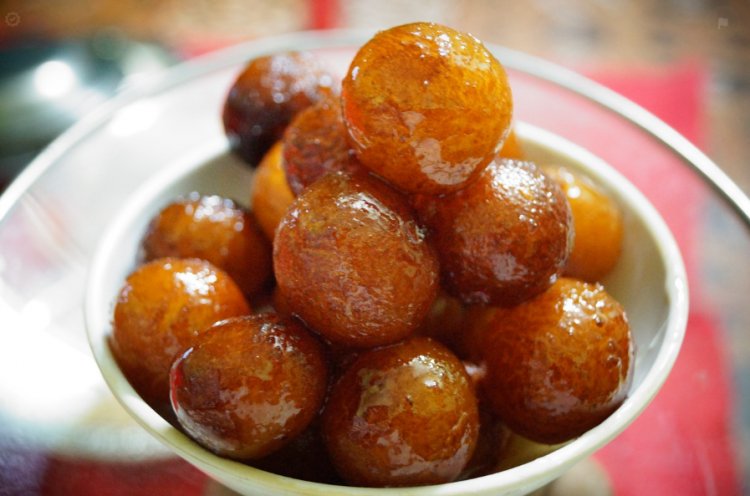La Amour: Exploring the Romantic Origins and Cuisine of Couples' Eats
In the realm of romantic dining experiences, few things rival the charm and allure of sharing a meal with a loved one. Across different cultures, there exists a phenomenon known as "couples' eats," where certain dishes are believed to enhance love, intimacy, and connection between partners. Let's delve into the origins, myths, and culinary delights of these romantic indulgences. #CouplesEats #FoodTraditions #RomanticDining #FoodMyths #FoodCulture #GulabJamun #IndianDesserts #SweetDelight #IndianCuisine #RestaurantRecommendations #UKRestaurants #IndianFoodUK

The Origins of Couples' Eats
The concept of couples' eats is deeply rooted in the idea that sharing food can strengthen bonds and ignite passion between partners. Many cultures have their own versions of these dishes, each with its own unique history and significance.
In Italy, for example, there's a tradition of sharing spaghetti in a dish known as "spaghetti alla chitarra," where the pasta is cut into long, thin strands resembling guitar strings. Legend has it that couples who share this dish will be bound together forever, much like the strands of pasta clinging to each other.
Similarly, in Japan, couples often share a bowl of "ramen," symbolizing the idea of two becoming one. The act of slurping noodles from the same bowl is believed to create a strong bond between partners.
Myths and Beliefs
Many couples' eats are steeped in myth and legend, with each dish believed to possess magical properties that can enhance love and romance. For example, in India, there's a belief that sharing a dish of "gulab jamun," a sweet dessert made from deep-fried dough soaked in sugar syrup, can bring sweetness and harmony to a relationship.
In Mexico, couples often share a dish of "mole," a rich and complex sauce made from chocolate and spices. It is said that eating mole together can spice up a relationship and add a touch of magic to the romance.
Culinary Delights of Couples' Eats
The types of food associated with couples' eats are as diverse as the cultures that produce them. From decadent desserts to savory mains, these dishes are often chosen for their ability to evoke feelings of warmth, comfort, and intimacy.
In France, couples may indulge in a plate of "coq au vin," a hearty chicken stew cooked in red wine, mushrooms, and bacon. This dish is not only delicious but also symbolizes the idea of sharing a warm and comforting meal with a loved one.
In Thailand, couples might enjoy a dish of "pad thai," a stir-fried noodle dish that is both flavorful and satisfying. The combination of sweet, sour, and savory flavors in pad thai is said to represent the balance and harmony that are essential in a successful relationship.
Gulab Jamun: A Delectable Dive into India's Sweet Delight

Gulab Jamun is one of India's most beloved and iconic desserts, cherished for its decadent sweetness and melt-in-your-mouth texture. This delectable treat is enjoyed across the country and is a staple at celebrations, festivals, and special occasions. Let's explore the origins, significance, and preparation of this delightful dessert.
Origins and Significance
The origins of Gulab Jamun can be traced back to medieval India, where it was introduced by Persian-speaking invaders. The name "Gulab Jamun" is derived from the Persian words "gulab," meaning rose water, and "jamun," referring to a dark purple fruit similar in size and shape to the dessert. Over time, Gulab Jamun became a popular sweet in Indian cuisine, beloved for its rich flavor and aromatic essence.
In Indian culture, Gulab Jamun holds a special place as a symbol of celebration and joy. It is often served at weddings, festivals like Diwali and Eid, and other auspicious occasions. The sweetness of Gulab Jamun is believed to signify the sweet moments in life and is often shared with loved ones as a gesture of love and affection.
Ingredients and Preparation
Gulab Jamun is made from a few simple ingredients, primarily khoya (reduced milk solids), sugar, and a pinch of flour. These ingredients are mixed together to form a soft dough, which is then shaped into small balls and deep-fried until golden brown. The fried balls are then soaked in a sugar syrup flavored with rose water, cardamom, and saffron, giving Gulab Jamun its signature sweet and aromatic taste.
Recipe for Gulab Jamun
Here is a simple recipe to make Gulab Jamun at home:
Ingredients:
- 1 cup khoya (milk solids)
- 2 tbsp all-purpose flour
- A pinch of baking soda
- 1/4 cup milk
- Oil for frying
For the Sugar Syrup:
- 1 cup sugar
- 1 cup water
- A few strands of saffron
- 1/2 tsp cardamom powder
- 1 tsp rose water
Instructions:
- In a bowl, crumble the khoya and add the all-purpose flour and baking soda. Mix well.
- Gradually add milk and knead the mixture into a soft dough. Cover and let it rest for 10-15 minutes.
- Meanwhile, prepare the sugar syrup by boiling sugar, water, saffron, and cardamom powder until it reaches a syrupy consistency. Add rose water and set aside.
- Heat oil in a pan for frying. Divide the dough into small portions and roll them into smooth balls.
- Fry the balls in the hot oil over low heat until golden brown. Drain and immediately soak them in the warm sugar syrup.
- Let the Gulab Jamun soak for at least an hour before serving.
Gulab Jamun is a quintessential Indian dessert that embodies the rich flavors and cultural heritage of the country. Whether enjoyed at a festive gathering or as a sweet indulgence at home, Gulab Jamun never fails to delight the taste buds and warm the heart.
Recommended Indian Restaurants in the UK
-
Dishoom: With locations in London, Edinburgh, Manchester, and other cities, Dishoom offers a modern take on traditional Indian cuisine in a stylish setting.
-
Tamarind: Located in London, Tamarind is a Michelin-starred restaurant known for its exquisite Indian dishes and elegant atmosphere.
-
Gymkhana: Another Michelin-starred restaurant in London, Gymkhana offers a sophisticated dining experience with a menu featuring classic and contemporary Indian dishes.
-
Brigadiers: Also in London, Brigadiers is a vibrant Indian restaurant and bar that serves up a range of grilled meats, seafood, and traditional Indian dishes.
-
Trishna: A sister restaurant to Gymkhana, Trishna is located in London's Marylebone neighborhood and specializes in coastal Indian cuisine.
-
Dabbawal: With locations in Newcastle and Jesmond, Dabbawal offers a casual dining experience with a menu of street food-inspired Indian dishes.
-
Mowgli Street Food: With several locations across the UK, Mowgli Street Food serves up a range of traditional Indian dishes in a casual, communal dining setting.
-
Zaika: Located in Kensington, London, Zaika offers a fine dining experience with a menu featuring authentic Indian flavors and ingredients.
-
Raja Monkey: Based in Birmingham, Raja Monkey is known for its creative takes on South Indian street food classics.
-
The Cinnamon Club: Located in Westminster, London, The Cinnamon Club offers a modern, innovative take on Indian cuisine in a stunning setting.
These restaurants offer a range of dining experiences, from casual and relaxed to elegant and upscale, showcasing the diversity and richness of Indian cuisine in the UK.
What's Your Reaction?





















